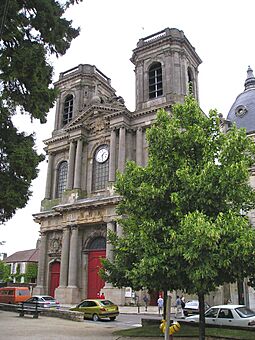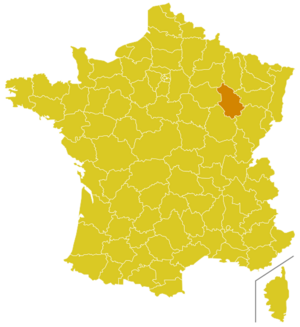Roman Catholic Diocese of Langres facts for kids
Quick facts for kids Diocese of LangresDioecesis Lingonensis Diocèse de Langres |
|
|---|---|

Langres Cathedral
|
|
| Location | |
| Country | |
| Ecclesiastical province | Reims |
| Metropolitan | Archdiocese of Reims |
| Statistics | |
| Area | 6,250 km2 (2,410 sq mi) |
| Population - Total - Catholics |
(as of 2004) 193,768 140,000 (72.3%) |
| Information | |
| Denomination | Catholic |
| Sui iuris church | Latin Church |
| Rite | Roman Rite |
| Established | 3rd Century |
| Cathedral | Cathedral of St. Mammes in Langres |
| Patron saint | St. Mammes of Caesarea |
| Current leadership | |
| Pope | Francis |
| Bishop | Joseph de Metz-Noblat |
| Metropolitan Archbishop | Éric de Moulins-Beaufort |
| Map | |
 |
|
The Diocese of Langres is a special area in France that belongs to the Catholic Church. It covers the region called Haute-Marne. The word "diocese" means a district that a bishop oversees.
This diocese is currently part of the Archdiocese of Reims. Before 2002, it was part of the Archdiocese of Lyon. The current bishop is Joseph Marie Edouard de Metz-Noblat. He became bishop on January 21, 2014. The diocese covers about 6,250 square kilometers (2,413 square miles). Around 140,000 people in this area are Catholic.
Contents
A Look Back: History of Langres Diocese
Early Beginnings
Historians believe the Diocese of Langres was started around the mid-300s. The first three bishops might have been Senator, Justus, and Didier de Langres. Didier was a martyr, meaning he died for his beliefs, around the year 407. This happened during an invasion by a group called the Vandals.
Becoming a Prince-Bishopric
In 1179, a powerful leader named Hugh III, Duke of Burgundy gave the city of Langres to his uncle, Gautier of Burgundy. Gautier was the bishop at the time. This made him a "prince-bishop," meaning he had both religious and political power. Later, Langres became a "duchy," which was a special territory ruled by a duke. This gave the Duke-Bishop of Langres an important role in French history. He even had a higher rank than the Archbishop of Lyon during the crowning of French kings.
Important Saints and People
The main patron saint of the diocese is Mammes of Caesarea. He was a martyr from the 200s. The main church, called the Langres Cathedral, is named after him. This cathedral was built in the late 1100s.
The diocese also honors other saints. Some of them are:
- Valerius, who was martyred in the 400s.
- Godo, a hermit from the 600s.
- Gengulphus, a martyr from the 700s.
Some famous people from the diocese include:
- Nicolas de Clémenges (1300s-1400s), a smart writer about religious topics.
- Edmond Richer (1560–1631), a legal expert.
- Pierre Le Moyne (1602–71), a Jesuit writer.
- Diderot (1713–84), a famous philosopher.
Three people from the diocese who helped spread Christianity in Canada were:
- Gerard Voinchet (1640–95)
- Jeanne Mance (1606–73)
- Mariet (died 1704)
Important Monasteries and Abbeys
Many religious communities were founded in the Langres diocese:
- The Benedictine Poulangy Abbey was started in the 1000s.
- Morimond Abbey was founded in 1125. It was the fourth monastery started by the Cîteaux order.
- The Augustinian priory of the Val des Ecoliers was founded in 1212. It was started by four teachers from the Paris University who wanted a quiet place to live and study.
Unique Traditions
The diocese had some interesting traditions:
- The "Scourging of the Alleluia": In the Middle Ages, on the day when the "Alleluia" song was left out of church services, a special top with "Alleluia" written on it was "whipped" out of the church. Choirboys sang psalms, wishing it a good journey until Easter. This tradition is no longer practiced.
- The "Pardon of Chaumont": This is a very famous event. In 1475, a man from Chaumont named Jean de Montmirail, who was friends with Pope Sixtus IV, got a special permission. This permission said that whenever the feast of St. John the Baptist fell on a Sunday, people who confessed their sins and visited the church in Chaumont would receive a special forgiveness, called a jubilee indulgence. This led to the "Pardon" of Chaumont. It was celebrated 61 times between 1476 and 1905. In the Middle Ages, this event included plays about the life of St. John the Baptist. These plays attracted many people. By the 1700s, the "Pardon" became a purely religious ceremony.
Religious Conflicts
The town of Vassy in the Diocese of Langres was the site of important events in 1562. Riots happened there between Catholics and Protestants. These events helped start the religious conflicts in France (see Huguenots).
Church Meetings and Changes
Many important church meetings, called synods, were held in Langres. These meetings discussed church rules and practices. Some of the most important ones were in 1404, 1421, 1621, and several in the 1800s. These later meetings aimed to bring back the old church organization and encourage priests to use the Roman Breviary, a book of prayers.
Special Places of Pilgrimage
People in the diocese often visit special holy places called pilgrimages. Some of these include:
- Our Lady of Montrol near Arc-en-Barrois (from the 1600s)
- Our Lady of the Hermits at Cuves
- Our Lady of Victories at Bourmont
- St. Joseph, Protector of the Souls in Purgatory, at Maranville
Re-establishment of the Diocese
The Diocese of Langres was temporarily closed in 1801 because of the Napoleonic Concordat, an agreement between France and the Pope. It was then joined with the Diocese of Dijon. However, this union was not fully complete. The See of Langres was officially re-established in 1817 by Pope Pius VII and King Louis XVIII. But it took until October 6, 1822, for the agreement to be finalized. The new Diocese of Langres included parishes from several older dioceses, making it a larger area.
Leaders of the Diocese: Bishops of Langres
The bishops are the main leaders of the diocese. Until 1016, they lived in Dijon. Until 1731, they also had religious power over the area that is now the Diocese of Dijon. Below is a list of the bishops of Langres.
Bishops from the Start to 1000
- c. 200 Senator
- c. 240 Justus
- c. 264 Desiderius (Didier, Dizier)
- Vacant
- 284–301 Martin
- 301–327 Honoratius
- 327–375 Urban of Langres
- 375–422 Paulinus I
- St. Martin (411–420)?
- 422–448 Fraterne I
- 448–455 Fraterne II
- 456–484 Aprunculus, St. Aprunculus
- 485–490 Armentaire
- 490–493 Venantius
- 493–498 Paulinus II (Paul)
- 498–501 Patiens
- 501–506 Albiso
- 506–539 Gregory of Langres, St. Gregory
- 539–572 Tetricus of Langres, St. Tetricus
- 572–583 Papoul
- 583–595 Mummole le Bon
- 595–618 Miget (Migetius)
- 618–628 Modoald
- 628–650 Berthoald
- 650–660 Sigoald
- 660–670 Wulfrand
- 670–680 Godin
- 680–682 Adoin
- 682–690 Garibald
- 690–713 Héron
- 713–742 Eustorge
- Died c. 759 Vaudier
- 752–772 Erlolf
- 772–778 Herulphe, Herulphus or Ariolf
- 778–790 Baldric
- 790–820 Belto, Betto
- 820–838 Albéric
- 838–856 Thibaut I
- 859–880 Isaac
- 880–888 Gilon de Tournus
- 888–890 Argrin, first time
- 890–894 Thibaut II
- 894–910 Argrin, second time
- 910–922 Garnier I
- 922–931 Gotzelin
- 932 Lethéric
- 932–948 Héric or Héry
- 948–969 Achard
- 969–980 Vidric
- 980–1015 Bruno of Roucy
Bishops from 1000 to 1300
- 1016–1031 Lambert I
- 1031 Richard
- 1031–1049 Hugo de Breteuil
- 1050–1065 Harduin
- 1065–1085 Raynard of Bar
- 1085–1111 Robert of Burgundy
- 1111–1113 Lambert II
- 1113–1125 Joceran de Brancion
- 1126–1136 Guillenc
- 1136–1138 Guillaume I de Sabran
- 1138–1163 Godefroy de la Roche Vanneau
- 1163–1179 Walter of Burgundy, Gauthier of Burgundy
- 1179–1193 Manasses of Bar
- 1193–1199 Garnier II de Rochefort
- 1200–1205 Hutin de Vandeuvre
- 1205–1210 Robert de Châtillon
- 1210–1220 Guillaume de Joinville
- 1220–1236 Hugues de Montréal
- 1236–1242 Robert de Torote
- 1242–1250 Hugues de Rochecorbon
- 1250–1266 Guy de Rochefort
- 1266–1291 Guy de Genève
- 1294–1305 Jean de Rochefort
Bishops from 1300 to 1500
- 1305–1306 Bertrand de Got
- 1306–1318 Guillaume de Durfort de Duras
- 1318–1324 Louis of Poitiers-Valentinois
- 1324–1329 Pierre de Rochefort
- 1329–1335 Jean de Chalon-Arlay
- 1335–1338 Guy Baudet
- 1338–1342 Jean des Prez
- 1342–1344 Jean d'Arcy
- 1344–1345 Hugues de Pomarc
- 1345–1374 William of Poitiers
- 1374–1395 Bernard de la Tour d'Auvergne
- 1395–1413 Louis I of Bar
- 1413–1433 Charles de Poitiers
- 1433 Jean Gobillon
- 1433–1452 Philippe de Vienne
- 1452–1453 Jean d'Aussy
- 1453–1481 Guy Bernard
- 1481–1497 Jean I d'Amboise
- 1497–1512 Jean II d'Amboise
Bishops from 1500 to 1700
- 1512–1529 Michel Boudet
- 1530–1561 Claude de Longwy
- 1562–1565 Louis de Bourbon
- 1566–1568 Pierre de Gondi
- 1569–1614 Charles de Perusse des Cars
- 1615–1655 Sébastien Zamet
- 1655–1670 Louis Barbier de La Rivière
- 1671–1695 Louis Armand de Simiane de Gordes
- 1696–1724 François-Louis de Clermont-Tonnerre
Bishops from 1700 to 1900
- 1724–1733 Pierre de Pardaillan de Gondrin
- 1741–1770 Gilbert Gaspard de Montmorin de Saint-Hérem
- 1770–1802 César-Guillaume de La Luzerne
- 1791–1802 Hubert Wandilincourt
- vacancy
- 1817–1821 César-Guillaume de La Luzerne
- Gilbert-Paul Aragonès d'Orcet (1823–1832)
- Jacques-Marie-Adrien-Césaire Mathieu (1832–1834)
- Pierre-Louis Parisis (1834–1851)
- Jean-Jacques-Marie-Antoine Guerrin (1851–1877)
- Guillaume-Marie-Frédéric Bouange (1877–1884)
- Alphonse-Martin Larue (1884–1899)
- Sébastien Herscher (1899–1911)
Bishops from 1900 to Today
- Marie-Augustin-Olivier de Durfort de Civbac de Lorge (1911–1918)
- Théophile-Marie Louvard (1919–1924)
- Jean-Baptiste Thomas (1925–1929)
- Louis-Joseph Fillon (1929–1934)
- Georges-Eugène-Emile Choquet (1935–1938)
- Firmin Lamy (1938–1939)
- Louis Chiron (1939–1964)
- Alfred-Joseph Atton (1964–1975)
- Lucien Daloz (1975–1980)
- Léon Aimé Taverdet, F.M.C. (1981–1999)
- Philippe Jean Marie Joseph Gueneley (1999–2014)
- Joseph de Metz-Noblat (since 2014)
See also
- Catholic Church in France

